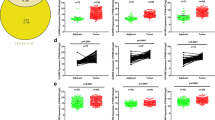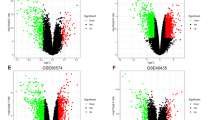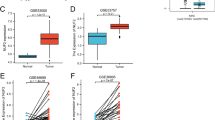Abstract
Integrins play an important role in cancer growth and metastasis. This study aimed at determining the predictive ability of integrins and associated genes identified through molecular network in clear cell renal cell carcinoma. A total of 525 patients with ccRCC from The Cancer Genome Atlas (TCGA) cohorts were collected in this study. The expression profile of integrins and related genes were obtained from the TCGA RNAseq database. Clinicopathological characteristics, including age, gender, tumor size, tumor node metastasis (TNM), tumor grade, stage, laterality, and overall survival were collected. Cox proportional hazards regression model as well as Kaplan–Meier curve were used to assess the relative factors. Genes of integrin family that showed certain correlations with overall survival (OS) were further validated in the Fudan University Shanghai Cancer Center (FUSCC) cohort. In the TCGA cohort, after Cox proportional hazards analysis, ITGA2B (hazards ratio (HR) = 1.232, 95 % CI 1.097 to 1.383) and ITGA8 (HR = 0.804, 95 % CI 0.696 to 0.930) were shown predictive of ccRCC prognosis. Low ITGA8 expression was associated with poor prognosis for OS (log-rank test, p < 0.0001), while high level of ITGA2B expression was correlated with poor prognosis for OS (log-rank test, p < 0.0001). This finding was validated in FUSCC cohort (log-rank test, all p < 0.05). As a result, low ITGA8 expression was associated with poor prognosis for OS (log-rank test, p = 0.0053), while high level of ITGA2B expression was correlated with poor prognosis for OS (log-rank test, p < 0.0001). Plus, low ITGA8 expression was associated with poor prognosis for disease-free survival (DFS) in the TCGA cohort (log-rank test, p < 0.0001). In the gene cluster network analysis, GIT1 and SHC1 associated with ITGA2B and ITGA8 were identified as independent predictive factors of overall survival of ccRCC. ITGA2B, ITGA8, GIT1, and SHC1 were identified as independent prognostic factors of overall survival of ccRCC. This method may act as a tool to reveal more prognostic-associated genes in ccRCC.



Similar content being viewed by others
References
Siegel RL, Miller KD, Jemal A. Cancer statistics, 2015. CA Cancer J Clin. 2015;65:5–29.
Liang L, Li L, Zeng J, Gao Y, Chen YL, Wang ZQ, et al. Inhibitory effect of silibinin on EGFR signal-induced renal cell carcinoma progression via suppression of the EGFR/MMP-9 signaling pathway. Oncol Rep. 2012;28:999–1005.
Ficarra V, Galfano A, Novara G, Iafrate M, Brunelli M, Secco S, et al. Risk stratification and prognostication of renal cell carcinoma. World J Urol. 2008;26:115–25.
Desgrosellier JS, Cheresh DA. Integrins in cancer: biological implications and therapeutic opportunities. Nat Rev Cancer. 2010;10:9–22.
Schwartz MA, Ginsberg MH. Networks and crosstalk: integrin signalling spreads. Nat Cell Biol. 2002;4:E65–8.
Hynes RO. Integrins: bidirectional, allosteric signaling machines. Cell. 2002;110:673–87.
Hehlgans S, Haase M, Cordes N. Signalling via integrins: implications for cell survival and anticancer strategies. Biochim Biophys Acta. 2007;1775:163–80.
Ahmed N, Riley C, Rice GE, Quinn MA, Baker MS. Alpha (v) beta (6) integrin-a marker for the malignant potential of epithelial ovarian cancer. J Histochem Cytochem. 2002;50:1371–80.
Elayadi AN, Samli KN, Prudkin L, Liu YH, Bian A, Xie XJ, et al. A peptide selected by biopanning identifies the integrin alphavbeta6 as a prognostic biomarker for nonsmall cell lung cancer. Cancer Res. 2007;67:5889–95.
Goldberg I, Davidson B, Reich R, Gotlieb WH, Ben-Baruch G, Bryne M, et al. Alphav integrin expression is a novel marker of poor prognosis in advanced-stage ovarian carcinoma. Clin Cancer Res. 2001;7:4073–9.
Kageshita T, Hamby CV, Hirai S, Kimura T, Ono T, Ferrone S. Alpha (v) beta3 expression on blood vessels and melanoma cells in primary lesions: differential association with tumor progression and clinical prognosis. Cancer Immunol Immunother. 2000;49:314–8.
Hazelbag S, Kenter GG, Gorter A, Dreef EJ, Koopman LA, Violette SM, et al. Overexpression of the alpha v beta 6 integrin in cervical squamous cell carcinoma is a prognostic factor for decreased survival. J Pathol. 2007;212:316–24.
Nikkola J, Vihinen P, Vlaykova T, Hahka-Kemppinen M, Heino J, Pyrhonen S. Integrin chains beta1 and alphav as prognostic factors in human metastatic melanoma. Melanoma Res. 2004;14:29–37.
Schittenhelm J, Schwab EI, Sperveslage J, Tatagiba M, Meyermann R, Fend F, et al. Longitudinal expression analysis of alphav integrins in human gliomas reveals upregulation of integrin alphavbeta3 as a negative prognostic factor. J Neuropathol Exp Neurol. 2013;72:194–210.
Vellon L, Menendez JA, Lupu R. Alphavbeta3 integrin regulates heregulin (HRG)-induced cell proliferation and survival in breast cancer. Oncogene. 2005;24:3759–73.
Zhang ZY, Xu KS, Wang JS, Yang GY, Wang W, Wang JY, et al. Integrin alphanvbeta6 acts as a prognostic indicator in gastric carcinoma. Clin Oncol R Coll Radiol. 2008;20:61–6.
Jiang Y-Z, Yu K-D, Zuo W-J, Peng W-T, Shao Z-M. Gata3 mutations define a unique subtype of luminal-like breast cancer with improved survival. Cancer. 2014;120:1329–37.
Song B, Wang Y, Xi Y, Kudo K, Bruheim S, Botchkina GI, et al. Mechanism of chemoresistance mediated by miR-140 in human osteosarcoma and colon cancer cells. Oncogene. 2009;28:4065–74.
Zhang YM, Dai BL, Zheng L, Zhan YZ, Zhang J, Smith WW, et al. A novel angiogenesis inhibitor impairs lovo cell survival via targeting against human VEGFR and its signaling pathway of phosphorylation. Cell Death Dis. 2012;3:e406.
Goodman SL, Picard M. Integrins as therapeutic targets. Trends Pharmacol Sci. 2012;33:405–12.
Tchaicha JH, Mobley AK, Hossain MG, Aldape KD, McCarty JH. A mosaic mouse model of astrocytoma identifies alphavbeta8 integrin as a negative regulator of tumor angiogenesis. Oncogene. 2010;29:4460–72.
Zutter MM. Integrin-mediated adhesion: tipping the balance between chemosensitivity and chemoresistance. Adv Exp Med Biol. 2007;608:87–100.
Mikkelsen T, Brodie C, Finniss S, Berens ME, Rennert JL, Nelson K, et al. Radiation sensitization of glioblastoma by cilengitide has unanticipated schedule-dependency. Int J Cancer. 2009;124:2719–27.
Albert JM, Cao C, Ling G, Leavitt L, Hallahan DE, Bo L. Integrin alpha (v) beta (3) antagonist cilengitide enhances efficacy of radiotherapy in endothelial cell and non-small-cell lung cancer models. Int J Radiat Oncol. 2006;65:1536–43.
Rivera J, Lozano ML, Navarro-Nunez L, Vicente V. Platelet receptors and signaling in the dynamics of thrombus formation. Haematologica. 2009;94:700–11.
Jain S, Harris J, Ware J. Platelets: linking hemostasis and cancer. Arterioscler Thromb Vasc Biol. 2010;30:2362–7.
Zhao F, Li L, Guan L, Yang H, Wu C, Liu Y. Roles for gp iib/iiia and alphavbeta3 integrins in mda-mb-231 cell invasion and shear flow-induced cancer cell mechanotransduction. Cancer Lett. 2014;344:62–73.
Marek I, Volkert G, Jahn A, Fahlbusch F, Zurn C, Ozcan Z, et al. Lack of alpha8 integrin leads to morphological changes in renal mesangial cells, but not in vascular smooth muscle cells. BMC Cell Biol. 2010;11:102.
Hartner A, Menendez-Castro C, Cordasic N, Marek I, Volkert G, Klanke B, et al. Tubulointerstitial de novo expression of the alpha8 integrin chain in a rodent model of renal fibrosis—a potential target for anti-fibrotic therapy? PLoS One. 2012;7:e48362.
Humbert C, Silbermann F, Morar B, Parisot M, Zarhrate M, Masson C, et al. Integrin alpha 8 recessive mutations are responsible for bilateral renal agenesis in humans. Am J Hum Genet. 2014;94:288–94.
Schlenker O, Rittinger K. Structures of dimeric GIT1 and trimeric beta-pix and implications for GIT-PIX complex assembly. J Mol Biol. 2009;386:280–9.
Hajdo-Milasinovic A, van der Kammen RA, Moneva Z, Collard JG. Rac3 inhibits adhesion and differentiation of neuronal cells by modifying GIT1 downstream signaling. J Cell Sci. 2009;122:2127–36.
Schmalzigaug R, Garron ML, Roseman JT, Xing Y, Davidson CE, Arold ST, et al. GIT1 utilizes a focal adhesion targeting-homology domain to bind paxillin. Cell Signal. 2007;19:1733–44.
Kao J, Salari K, Bocanegra M, Choi Y-L, Girard L, Gandhi J, et al. Molecular profiling of breast cancer cell lines defines relevant tumor models and provides a resource for cancer gene discovery. PLoS One. 2009;4:e6146.
Peng H, Dara L, Li TW, Zheng Y, Yang H, Tomasi ML, et al. MAT2B-GIT1 interplay activates MEK1/ERK 1 and 2 to induce growth in human liver and colon cancer. Hepatology. 2013;57:2299–313.
Majumder S, Sowden MP, Gerber SA, Thomas T, Christie CK, Mohan A, et al. G-protein-coupled receptor-2-interacting protein-1 is required for endothelial cell directional migration and tumor angiogenesis via cortactin-dependent lamellipodia formation. Arterioscler Thromb Vasc Biol. 2014;34:419–26.
Chan SH, Huang WC, Chang JW, Chang KJ, Kuo WH, Wang MY, et al. MicroRNA-149 targets GIT1 to suppress integrin signaling and breast cancer metastasis. Oncogene. 2014;33:4496–507.
Huang WC, Chan SH, Jang TH, Chang JW, Ko YC, Yen TC, et al. miRNA-491-5p and GIT1 serve as modulators and biomarkers for oral squamous cell carcinoma invasion and metastasis. Cancer Res. 2014;74:751–64.
Ravichandran KS. Signaling via Shc family adapter proteins. Oncogene. 2001;20:6322–30.
Veeramani S, Igawa T, Yuan TC, Lin FF, Lee MS, Lin JS, et al. Expression of p66(Shc) protein correlates with proliferation of human prostate cancer cells. Oncogene. 2005;24:7203–12.
Jackson JG, Yoneda T, Clark GM, Yee D. Elevated levels of p66 Shc are found in breast cancer cell lines and primary tumors with high metastatic potential. Clin Cancer Res. 2000;6:1135–9.
Rajendran M, Thomes P, Zhang L, Veeramani S, Lin MF. p66Shc—a longevity redox protein in human prostate cancer progression and metastasis: p66Shc in cancer progression and metastasis. Cancer Metastasis Rev. 2010;29:207–22.
Author information
Authors and Affiliations
Corresponding author
Additional information
Xiaolin Lu and Fangning Wan contributed equally to this work.
Electronic supplementary material
Below is the link to the electronic supplementary material.
ESM 1
(DOCX 45 kb)
Rights and permissions
About this article
Cite this article
Lu, X., Wan, F., Zhang, H. et al. ITGA2B and ITGA8 are predictive of prognosis in clear cell renal cell carcinoma patients. Tumor Biol. 37, 253–262 (2016). https://doi.org/10.1007/s13277-015-3792-5
Received:
Accepted:
Published:
Issue Date:
DOI: https://doi.org/10.1007/s13277-015-3792-5




